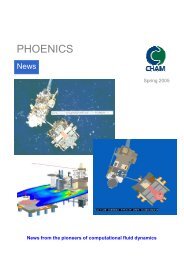PHOENICS - Arcofluid
PHOENICS - Arcofluid
PHOENICS - Arcofluid
Create successful ePaper yourself
Turn your PDF publications into a flip-book with our unique Google optimized e-Paper software.
<strong>PHOENICS</strong><br />
News<br />
<strong>PHOENICS</strong> Applications by the<br />
Tennessee Valley Authority (TVA)<br />
Summer 2008<br />
Computed Velocity Profile Contours at Several Locations<br />
of the Skimmer Wall<br />
TVA’s Boualem (Bo) Hadjerioua describes three<br />
TVA projects using <strong>PHOENICS</strong>. In the first two<br />
examples, several millions of dollars were saved.<br />
The full report can be found at:<br />
http://www.cham.co.uk/casestudies/Summary_PH<br />
OENICS_Projects.pdf<br />
1. TVA’s Colbert Fossil Plant Skimmer Wall<br />
The purpose of this study is to design an optimum<br />
skimmer wall at Colbert Fossil Plant (COF) to reduce derating<br />
due to thermal compliance and debris entrainment<br />
in the COF intake channel. The report presents the<br />
justification, potential benefits and the proposed design<br />
of a skimmer wall at COF.<br />
Barge Collecting Debris at COF, 2001<br />
The estimated capital cost to built a skimmer wall at COF<br />
is about $1.4 million. Therefore, just the savings from<br />
1999-2000 covered the cost of the skimmer wall, which<br />
is expected to last more than 50 years.<br />
Numerical modelling of the intake channel, with skimmer<br />
wall bottom at elevation 400 feet, has shown that the<br />
maximum velocity below the skimmer wall is 1.5 fps<br />
compared to the existing conditions of 0.5 fps. The<br />
computed velocity profiles were used to evaluate the<br />
316b issues (fish entrainment/ impingement by intake<br />
structures).<br />
2. TVA’s Kingston Fossil Plant Multi-Ports<br />
Diffusers<br />
Water temperature monitoring at COF indicates that an<br />
improvement in water temperature could be made if<br />
water is withdrawn from bottom layers of the Tennessee<br />
River. Installing a skimmer wall at the appropriate<br />
location and depth would accomplish this goal.<br />
A reduction system for control of nitrogen oxides (NOx) in<br />
the air emissions is being implemented at Kingston Fossil<br />
Plant (KIF). This new technique uses ammonia to reduce<br />
the emissions. The fly ash combustion by-product<br />
contains ammonia. The fly ash is sluiced to a series of<br />
ponds for settling, and the sluice-water is discharged<br />
from the ash pond into the intake channel.<br />
Survey at KIF intake Channel<br />
The study determined the optimum location and depth of<br />
the skimmer wall to minimize de-rating at COF without<br />
any negative environmental impact. COF also<br />
experienced a big inflow of debris that affected the plant<br />
generation’s efficiency. Therefore, by building a skimmer<br />
wall, two objectives would be targeted; lowering the<br />
intake water temperature during thermal stratification,<br />
and blocking the debris from getting in the intake<br />
channel. However, it was necessary to justify its<br />
implementation and the associated capital cost.<br />
A detailed study of the water temperature profile has<br />
shown that if a skimmer wall is built at COF with a<br />
bottom elevation at 400 feet, the savings from thermal<br />
compliance would have been about $354,000 in 1999.<br />
The debris problem at COF cost 80,000 MWh of derating<br />
at the plant in 2000.<br />
The maximum ammonia concentration entering the intake<br />
channel is predicted to be 2.85 mg/L. At such elevated<br />
levels, ammonia can be toxic to aquatic life. It potentially<br />
adds to the biological oxygen demand, lowering dissolved<br />
oxygen levels and encourages algal blooms. KIF is<br />
evaluating alternatives to avoid violating water quality<br />
standards for ammonia and prevent potential fish kills.<br />
News from the pioneers of computational fluid dynamics 5








